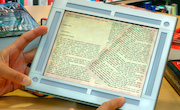Today's digital displays are heavy, fragile and expensive. They lack the resolution, flexibility and portability of paper. And they require lots of energy – both to manufacture and run.
We are developing low-cost, lightweight, portable displays that could one day match paper – or possibly even replace it. Besides enabling devices that are lighter than laptops and provide a more user-friendly browsing experience, these have the potential to reduce both paper use and waste because it is possible to ‘print’ many images to a single paper-like display.
Such displays could one day be used to produce newspapers, documents, books, billboards and other types of printed materials. We're particularly interested in displays that are reflective -- meaning they can use ambient light rather than having to generate their own light.
In addition, we are developing ways to 'print' these displays on plastic, with novel manufacturing technologies that would use less energy, produce less waste, and are less expensive than existing methods. |
|
 |
| |
 |
Low-cost, lightweight, portable displays have the potential to reduce waste and require less power to operate. |
 |
| |
|
